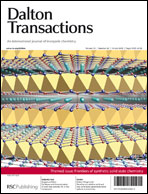Using time-resolved, in situ energy-dispersive X-ray diffraction (EDXRD), the formation of interstratified LDH structures, with alternate interlayer spaces occupied by different anions, have been demonstrated during anion exchange reactions. Novel hybrid LDH nanostructures can thus be prepared, combining the physicochemical properties of two intercalated anions plus those of the LDH host. A general trend is that inorganic–inorganic anion exchange reactions occur in a one-step process while inorganic–organic exchanges may proceed via a second-stage intermediate, suggesting that staging occurs partly as a result of organic–inorganic separation. Yet, other influencing parameters must be considered such as LDH host composition, LDH affinity for different anions and LDH particle size as well as extrinsic parameters like the reaction temperature. Hence, a correlation between the occurrence of staging phenomenon and the difficulty of the exchange of the initial anion is observed, suggesting that staging is needed to overcome the energy barrier in the case of the exchange by organic anions. Notwithstanding the LiAl2 system, staging has mainly been observed with Zn2Cr LDH host so far, a peculiar LDH composition with a unique Zn/Cr ratio of two and a local order of the cations within the hydroxide layers. The formation of a higher order-staged intermediate than stage two, observed during the exchange reaction of CO32− or SO42− anions with Zn2Cr–tartrate, is in favour of a Daumas–Herold model although this model implies a bending of LDH layers. The analysis of the X-ray powder diffraction pattern of Zn2Cr–Cl/tartrate second-stage intermediate, isolated almost as a pure phase during the exchange of Cl− with tartrate anions in Zn2Cr LDH, indicates a disorder in the stacking sequence and a relative proportion of the two kinds of interlayers slightly different from 50/50. Besides, the microstructural analysis of the XRD pattern reveals a great reduction of the stacking thickness during the anion exchange process but with no change of the in-plane coherent length, therefore no in-plane deformation of LDH host layers. Finally, the anion exchange properties of Zn2Cr–Cl/tartrate, investigated by means of EDXRD, show highly selective anion-exchange reactions, leading to the formation of new second-stage intermediates that cannot be prepared starting from the mono-intercalated Zn2Cr–Cl. This “Zn2Cr–Cl/tartrate approach” might constitute a new route for the synthesis of various mixed organic–inorganic anions-exchanged forms of LDH.


 Please wait while we load your content...
Please wait while we load your content...